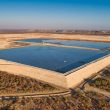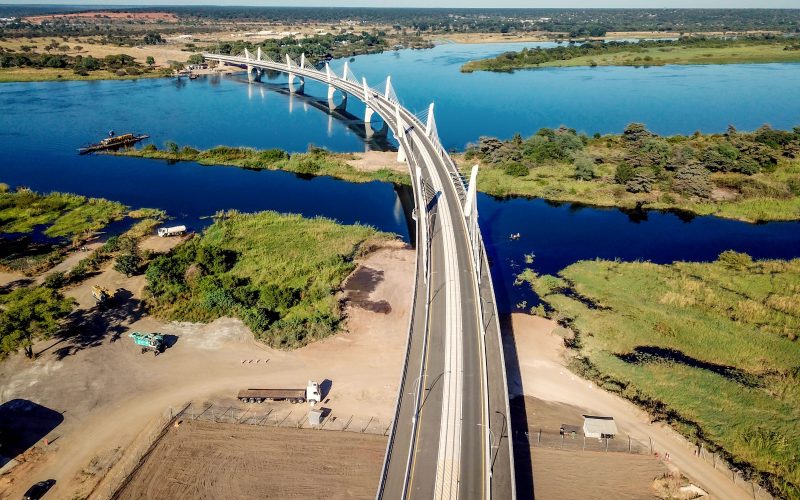For decades, the Zambezi River — a tourism marvel in its own right— has been a major hindrance to Botswana trade expansion to the north. It frustrated trade, increased the cost of doing business, increased the cost of goods and caused scores of fatal accidents over the years.
Finally, there is a new lease of life. Kazungula Bridge is an engineering marvel. It is a trade game changer, and centre of attraction for tourists.It took nearly two decades, and three presidents, for the project to move from conception to realization.
Kazungula Bridge concept came into being during the early years of President Festus Mogae and Zambia’s Levy Mwanawasa.
However, it was not until 2014, that the construction of the bridge started.
Initially, the project comprised of Botswana
and its sister countries, Zambia and Zimbabwe. However,due to financial difficulties and diplomatic issues, Zimbabwe
pulled out of the project.
Banked rolled in the main by African Development Bank, the Kazungula Bridge was officially commissioned by President
Mokgweetsi Masisi and the immediate former President of Zambia, Edgar Lungu in May 2021.
The bridge’s commissioning followed the commencement of Africa Continental Free Trade Area (AfCFTA) which started in January 2021.
When it comes into effect in stages over the next several months and years, the AfCFTA will cover a market of more than 1.2 billion people and up to $3 trillion in combined GDP, with the potential of increasing intra-African trade by over 50 percent, according to the United Nations Economic Commission for Africa.
According to the World Bank, meanwhile, the agreement could add $76 billion in income to the rest of the world. On its completion, the AfCFTA will become the largest free
trade area in the world since the establishment of the World Trade Organization.
Kazungula Birdge is a nice fit in the African countries’ ambition of creating the world’s largest trade area. In addition to the landmark agreement by African leaders, investment in infrastructure will be key to realization of the ideas set out by
the agreement’s founders.
Kazungula Bridge does not only open the doors in Zambia,but unleashes the potential for Botswana to do business with its business counterparts, and for African countries to do business with each other with the help of the Botswana-Zambia financed project.
It is all about creating impactful economic opportunities for the content, with everybodybenefiting.The 923-meter bridge, with two border facilities on either
side, will support trade and transport along the North-South Corridor, and the Trans-African Highway on the Cape to
Cairo route.
The opening of the Kazungula Bridge, linking Botswana and Zambia over the Zambezi River, means travellers no longer need to rely on pontoon boats to cross at this location.
The bridge is a combined transport configuration, including two car lanes in each direction, a single rail track, and pedestrian
walkways on both sides.
Under the One-Stop Border Post concept, there is no longer a need to stop twice, as it used to happen. Commuters only stop at the border post of the exit country. The transit timethat was spent by traders using this road is therefore reduced tremendously.
The African Development Bank Group supported the project through an African Development Fund loan of $76.5 million
to the Government of Zambia.
In addition to funding from the two governments, the overall project was co-financed by the Japanese International
Cooperation Agency and the EU-Africa Infrastructure Trust Fund.
The total cost of the project was $259.3 million.The project sought to facilitate trade activities and the global competitiveness of Zambia and Botswana, improve the regional connectivity of the North-South corridor and
contribute to improved regional integration of the Southern African Development Community (SADC).
The project included the construction of two One-Stop Border Posts, one on each side of the Zambia/Botswana border. Construction activities were further complemented
by soft activities such as technical assistance and capacity building to cover trade facilitation and the framework for
One-Stop Border Post operations – critical for efficient operation and the realization of project benefits.
The new Kazungula Bridge will be jointly owned by the governments of Botswana and Zambia, and funded by toll fees. The border post and access roads in each country will
be owned by the respective governments, along with the newly formed Kazungula Bridge Authority.
The entity will be responsible for operating and maintenance of the entire
infrastructure. The project was underpinned by the AfDB’s 10-Year Strategy (2013–2022), whose core priority areas include infrastructure development and regional integration.
The Kazungula Bridge Project is also a clear manifestation of the Bank’s High 5 priorities, specifically, “Integrate Africa” and “Improving the quality of life of the people of Africa,” by providing increased livelihood potential for the people in the project area.
At the International Customs Day Commemoration on 26th January 2022 Botswana Unified Revenue Service Commissioner – Customs, Segolo Lekau revealed that since its officially opening the Kanzungula Bridge has raked in over P18 million in toll gates revenue.
He said on a monthly basis the revenue service collects about P2 million from Kazungula toll gates charges.
FACTS
FINANCING COST: $259.3 million
OWNERS: Governments of Botswana and Zambia
MANAGER: Kazungula Bridge Authority
MONTHLY TOLL GATES REVENUE : P2 MILLION




